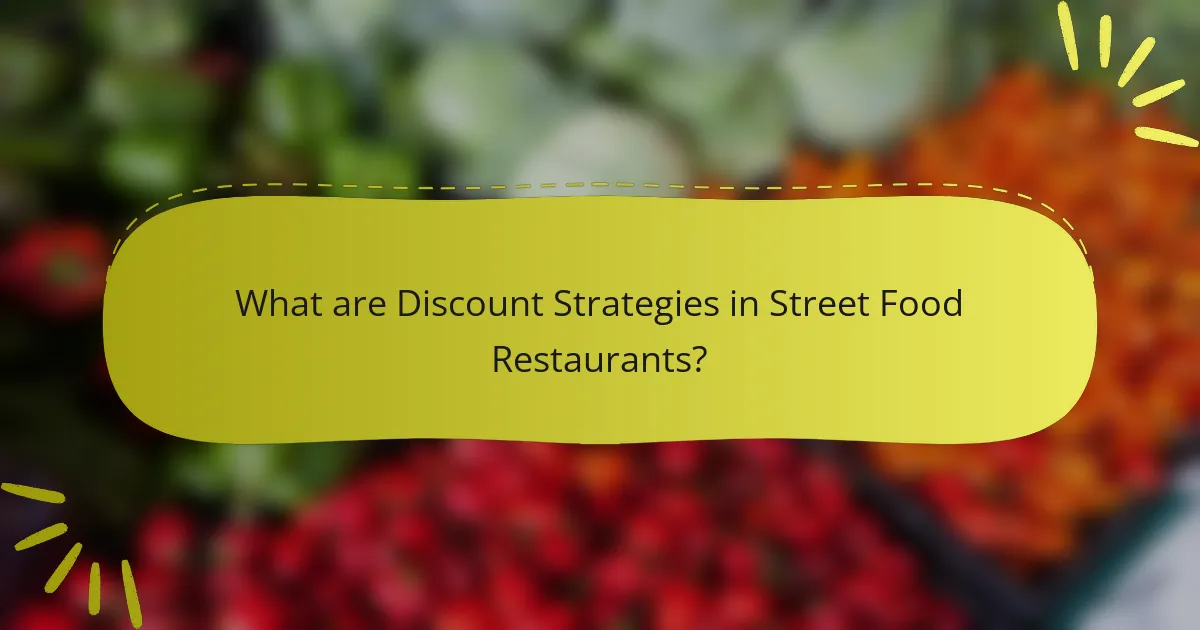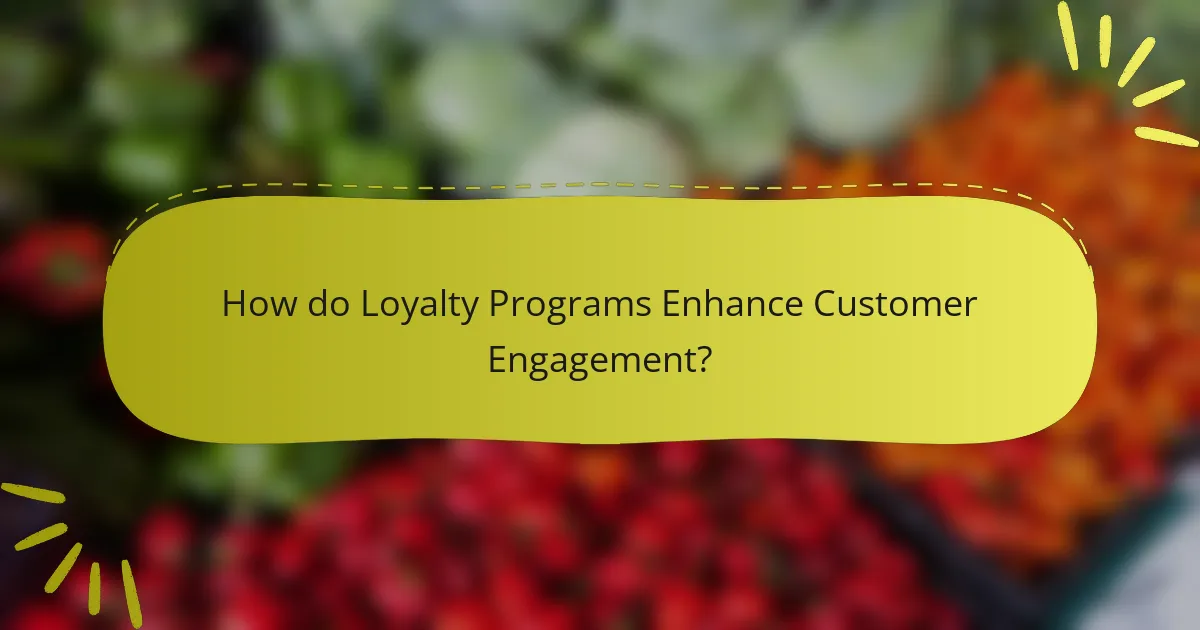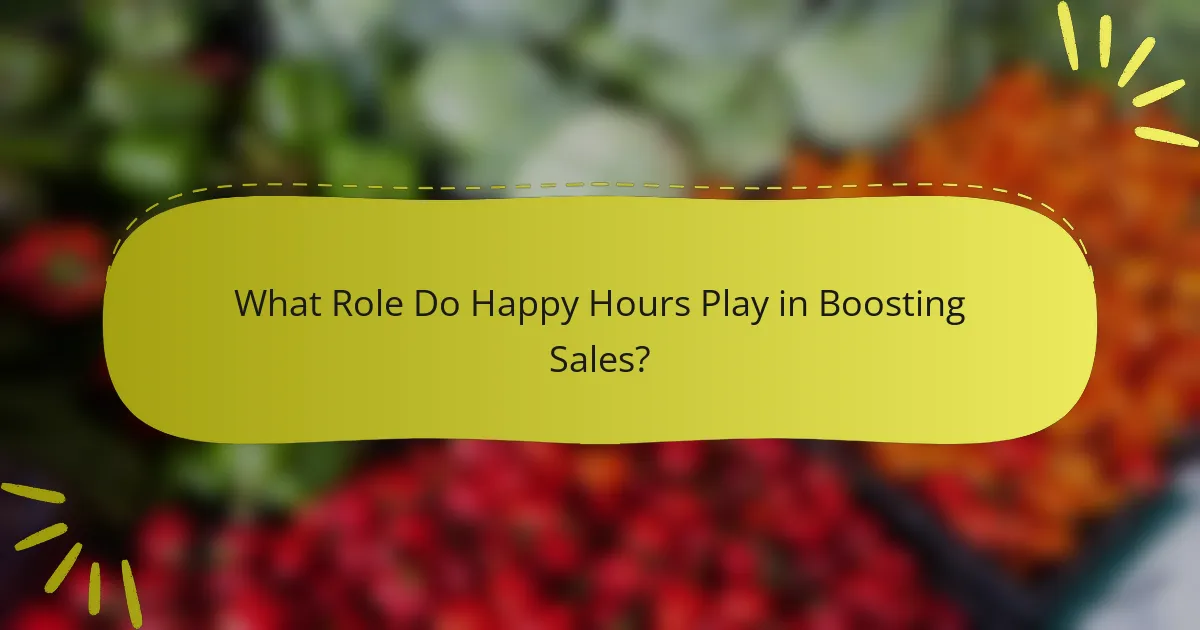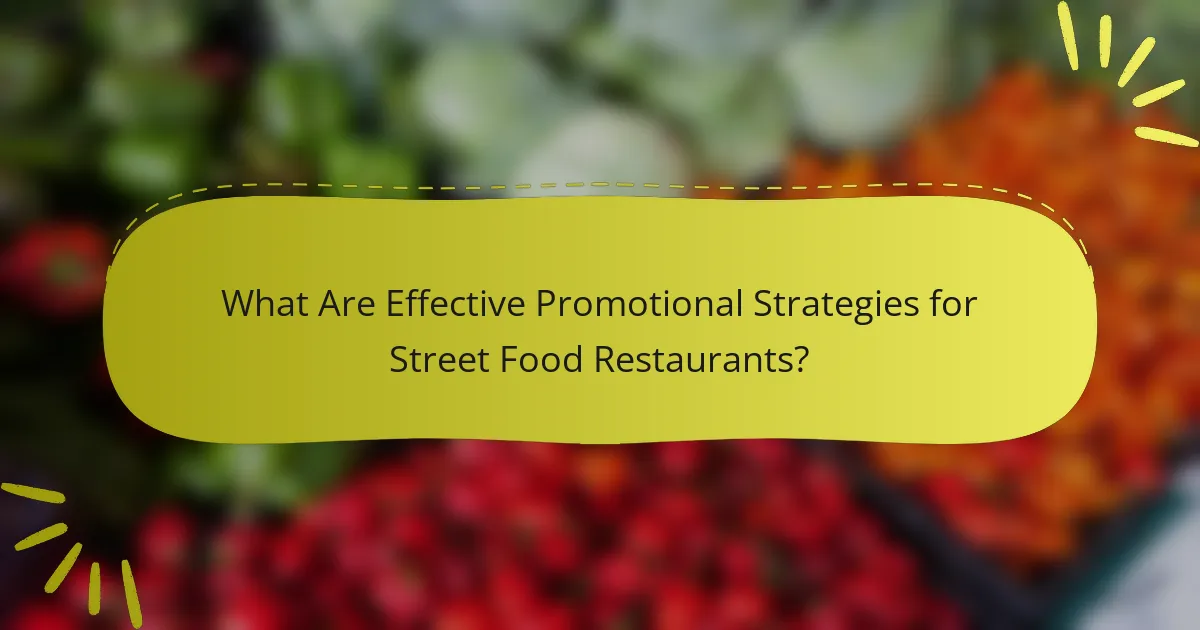Discount strategies in street food restaurants are essential methods used to attract customers and enhance sales. Key strategies include loyalty programs, which reward repeat customers and foster engagement, and happy hours that increase foot traffic by offering reduced prices during specific times. Additionally, promotional tactics such as limited-time offers and social media marketing play a significant role in driving customer interest and boosting overall profitability. Research indicates that these strategies not only enhance customer retention but also create a deeper emotional connection between customers and the restaurant brands.

What are Discount Strategies in Street Food Restaurants?
Discount strategies in street food restaurants involve various methods to attract customers and increase sales. Common strategies include loyalty programs that reward repeat customers with discounts or free items. Happy hours are another tactic, offering reduced prices during specific times to boost foot traffic. Promotions, such as limited-time offers or meal deals, create urgency and encourage purchases. These strategies are effective in fostering customer retention and enhancing overall profitability. For example, a study by the National Restaurant Association found that 70% of consumers are more likely to visit a restaurant with a loyalty program.
How do discount strategies impact customer behavior?
Discount strategies significantly influence customer behavior by incentivizing purchases and enhancing customer loyalty. Customers often perceive discounts as a value opportunity. This perception can lead to increased foot traffic and sales volume. Research indicates that 68% of consumers are more likely to buy a product when offered a discount. Additionally, loyalty programs that incorporate discounts can improve repeat visits. For instance, a study found that 83% of customers are more likely to return if they receive rewards. Overall, effective discount strategies can drive customer engagement and boost revenue for street food restaurants.
What psychological factors influence the effectiveness of discounts?
Psychological factors that influence the effectiveness of discounts include perceived value, scarcity, and social proof. Perceived value refers to how customers assess the worth of a discount. A higher perceived value increases the likelihood of purchase. Scarcity creates urgency, prompting customers to act quickly. When discounts are limited in time or quantity, they become more attractive. Social proof involves the influence of others’ behavior on purchasing decisions. Customers are more likely to buy when they see others taking advantage of discounts. Research shows that these factors significantly impact consumer behavior, enhancing the effectiveness of promotional strategies.
How do discounts affect customer retention in street food restaurants?
Discounts positively affect customer retention in street food restaurants. They incentivize repeat visits by creating a perception of value. Customers are more likely to return if they feel they are receiving a good deal. Research indicates that 60% of customers are motivated by discounts to revisit a restaurant. Additionally, discounts can encourage word-of-mouth marketing. Satisfied customers often share their experiences with friends, increasing new customer acquisition. Overall, strategic discounting fosters loyalty and enhances customer engagement in street food settings.
What types of discount strategies are commonly used?
Commonly used discount strategies include percentage discounts, buy-one-get-one-free offers, and loyalty programs. Percentage discounts reduce the price by a specific percentage. For example, a 20% discount on a meal encourages customers to purchase. Buy-one-get-one-free offers incentivize customers to buy more by providing an additional item for free. Loyalty programs reward repeat customers with discounts or points redeemable for future purchases. Happy hours offer time-limited discounts to increase sales during slower periods. These strategies are effective in attracting new customers and retaining existing ones.
How do loyalty programs work in street food restaurants?
Loyalty programs in street food restaurants reward customers for repeat purchases. Customers typically enroll in these programs through a mobile app or physical card. Upon making purchases, customers accumulate points or stamps. These points can later be redeemed for discounts, free items, or exclusive offers. Many street food vendors use simple systems, like buy-five-get-one-free. This encourages frequent visits and builds customer loyalty. According to a study by the National Restaurant Association, 70% of consumers are more likely to choose a restaurant with a loyalty program.
What are the key features of effective happy hour promotions?
Effective happy hour promotions typically feature discounted prices, a limited time frame, and a targeted audience. Discounts often include reduced prices on drinks and appetizers, encouraging increased sales during off-peak hours. A specific time frame, such as 4 PM to 7 PM, creates urgency and encourages patrons to visit during those hours. Targeting a specific audience, such as young professionals or college students, can enhance engagement. Additionally, offering unique menu items exclusive to happy hour can attract more customers. Promotions may also include themed events, live music, or games to enhance the experience. These features collectively drive foot traffic and boost revenue for establishments.
What seasonal promotions can street food restaurants implement?
Street food restaurants can implement seasonal promotions such as holiday-themed menus and discounts. These promotions can attract customers looking for festive dining experiences. For instance, offering special items during summer festivals can increase foot traffic. Additionally, providing discounts during slow seasons can boost sales. Research shows that limited-time offers can create urgency and encourage purchases. Seasonal promotions can also include collaborations with local events, enhancing visibility. By aligning with community activities, restaurants can draw in larger crowds. Overall, seasonal promotions effectively engage customers and increase revenue.

How do Loyalty Programs Enhance Customer Engagement?
Loyalty programs enhance customer engagement by incentivizing repeat purchases. They reward customers with points, discounts, or exclusive offers for their loyalty. This creates a sense of belonging and appreciation among customers. Research indicates that customers who participate in loyalty programs are 60% more likely to return. Additionally, loyalty programs provide valuable data on customer preferences. This data allows businesses to tailor marketing efforts and improve customer experience. Ultimately, loyalty programs foster a deeper emotional connection between customers and brands.
What are the main components of a successful loyalty program?
A successful loyalty program consists of clear rewards, easy enrollment, personalized experiences, and effective communication. Clear rewards motivate customers to participate. Programs should offer tangible benefits that are valued by customers. Easy enrollment simplifies the joining process, encouraging more sign-ups. Personalized experiences enhance customer engagement by tailoring offers to individual preferences. Effective communication keeps customers informed about rewards and program updates. Research shows that programs with these components can increase customer retention by up to 20%.
How do point systems incentivize repeat visits?
Point systems incentivize repeat visits by rewarding customers with points for each purchase. These points can be redeemed for discounts, free items, or exclusive offers. This creates a sense of value and encourages customers to return to accumulate more points. Research shows that loyalty programs can increase customer retention by up to 20%. Additionally, the anticipation of rewards motivates customers to choose a specific restaurant over competitors. The psychological principle of loss aversion also plays a role; customers may feel they are losing out if they do not return to earn points. Overall, point systems effectively drive repeat business through tangible rewards and emotional incentives.
What role does customer feedback play in loyalty program design?
Customer feedback is essential in loyalty program design. It helps identify customer preferences and pain points. By analyzing feedback, businesses can tailor rewards that resonate with their audience. This personalization increases engagement and satisfaction. Additionally, feedback allows for continuous improvement of the program. A study by the Harvard Business Review found that companies using customer insights in program design see higher retention rates. Thus, integrating customer feedback leads to more effective and appealing loyalty programs.
How can street food restaurants tailor loyalty programs to their audience?
Street food restaurants can tailor loyalty programs to their audience by understanding customer preferences and behaviors. They should analyze purchasing patterns to identify popular menu items. Offering rewards for these items can enhance customer engagement. Implementing mobile apps can streamline the loyalty process and provide personalized offers. Additionally, incorporating social media feedback can help refine loyalty incentives. Research shows that 70% of consumers prefer personalized rewards. This data supports the effectiveness of tailored loyalty programs in increasing customer retention.
What demographic factors should be considered when designing loyalty programs?
Age, income, gender, and location are key demographic factors to consider when designing loyalty programs. Age influences preferences for rewards and communication channels. Younger customers may prefer digital engagement while older customers might favor traditional methods. Income affects spending habits and loyalty program attractiveness. Higher-income individuals may seek premium rewards, while lower-income customers may prioritize discounts. Gender can influence product preferences and promotional messaging. Lastly, location impacts cultural preferences and accessibility to the restaurant. Understanding these factors enhances program effectiveness and customer engagement.
How can technology enhance the effectiveness of loyalty programs?
Technology can enhance the effectiveness of loyalty programs by providing data-driven insights and personalized experiences. Advanced analytics allows businesses to track customer behavior and preferences. This data enables targeted promotions that resonate with individual customers. Mobile apps facilitate easy access to loyalty rewards and updates. Customers can receive real-time notifications about special offers or points accumulation. Integration with social media enhances engagement and encourages sharing of rewards. Moreover, technology streamlines the redemption process, making it seamless for customers. According to a study by Bond Brand Loyalty, 79% of consumers are more likely to engage with brands that offer personalized experiences.

What Role Do Happy Hours Play in Boosting Sales?
Happy hours significantly boost sales in restaurants by attracting more customers during off-peak times. They create a sense of urgency and excitement, encouraging patrons to visit. Discounts on drinks and food increase overall spending per visit. Research shows that establishments offering happy hours can see a sales increase of 20% to 30%. This strategy also enhances customer loyalty, as patrons associate the restaurant with value. Happy hours can lead to repeat visits, further solidifying a restaurant’s customer base. In summary, happy hours effectively drive higher sales and customer engagement in the competitive food industry.
What are the benefits of implementing happy hour promotions?
Happy hour promotions increase customer traffic and boost sales during off-peak hours. These promotions attract new customers who may not visit otherwise. Increased foot traffic can lead to higher overall sales as customers often purchase additional items. Happy hour promotions also enhance customer satisfaction by offering value for money. According to a study by the National Restaurant Association, promotional events can increase sales by up to 20%. Additionally, happy hours can encourage repeat visits, fostering customer loyalty. This strategy helps restaurants build a community atmosphere, enhancing customer relationships.
How do happy hours attract new customers to street food restaurants?
Happy hours attract new customers to street food restaurants by offering discounts on food and beverages. These limited-time promotions create a sense of urgency for potential customers. The lower prices encourage trial, allowing customers to sample various menu items. Additionally, happy hours often feature unique offerings that highlight the restaurant’s specialties. Social media marketing amplifies these promotions, reaching a broader audience. Research shows that restaurants with happy hour promotions see a 20% increase in foot traffic during those hours. This increase in visitors can lead to repeat customers who return for the value and experience.
What are the best practices for scheduling happy hours?
The best practices for scheduling happy hours include selecting optimal days and times. Research indicates that weekdays, particularly Thursday and Friday, attract more patrons. Timing should typically fall between 4 PM and 7 PM to maximize attendance.
Offering a mix of drink and food specials enhances appeal. Promotions should be clearly advertised through social media and in-house signage. Monitoring customer feedback helps refine offerings and scheduling.
Data shows restaurants that consistently engage with customers see higher retention rates. Happy hours should align with local events or holidays to draw larger crowds. Establishing a regular schedule fosters customer loyalty and anticipation.
How can happy hour promotions be optimized for maximum impact?
Happy hour promotions can be optimized for maximum impact by strategically timing them and tailoring offers to customer preferences. Research shows that promotions should align with peak customer traffic times to maximize attendance. Offering a variety of discounts, such as percentage off or buy-one-get-one deals, can cater to different customer segments. Engaging social media campaigns that promote these happy hours can increase visibility and attract more patrons.
Additionally, incorporating themed events or live entertainment during happy hours can enhance the overall experience, encouraging longer stays and increased spending. Data indicates that venues with unique themes during promotions see a 20% increase in customer retention. Finally, gathering customer feedback post-event can provide insights for future optimizations, ensuring the promotions continue to resonate with the target audience.
What types of discounts work best during happy hours?
Percentage discounts on food and drinks work best during happy hours. These discounts typically range from 20% to 50%. Such reductions attract more customers looking for value. Buy-one-get-one-free offers are also popular. They encourage patrons to purchase more items. Time-limited discounts create urgency, prompting immediate visits. For example, offering discounts during specific hours can boost sales. Research shows that happy hour promotions increase foot traffic by up to 30%. Implementing these strategies can significantly enhance customer engagement and revenue.
How can social media be used to promote happy hour events?
Social media can effectively promote happy hour events by creating targeted advertisements. These ads can reach specific demographics interested in dining out. Engaging content, such as eye-catching images and videos of food and drinks, can attract attention. Utilizing platforms like Instagram and Facebook allows for event pages that provide details. Posting countdowns and reminders can build anticipation among followers. Encouraging user-generated content can enhance visibility as patrons share their experiences. Collaborating with local influencers can expand reach to new audiences. According to a study by Sprout Social, 54% of consumers use social media to research food and drink options. This highlights the importance of an active social media presence for promoting happy hour events.

What Are Effective Promotional Strategies for Street Food Restaurants?
Effective promotional strategies for street food restaurants include leveraging social media marketing, offering loyalty programs, and hosting events. Social media marketing helps to reach a broader audience quickly. Platforms like Instagram and Facebook allow restaurants to showcase their menu visually. Loyalty programs encourage repeat business by rewarding customers for their purchases. Hosting events or themed nights can attract new customers and create buzz. These strategies have been proven to increase foot traffic and sales in the competitive street food market.
How do promotional events drive customer traffic?
Promotional events drive customer traffic by creating excitement and attracting attention. They often feature limited-time offers that encourage immediate purchases. These events can include discounts, giveaways, or special menu items. Such incentives motivate customers to visit the restaurant rather than competitors. According to a survey by Eventbrite, 79% of consumers prefer to attend promotional events that offer exclusive deals. This indicates that promotional events effectively influence consumer behavior. Additionally, social media buzz generated during these events can further amplify reach and engagement. Increased foot traffic during promotional events can lead to higher sales and customer loyalty.
What types of promotional events resonate with street food customers?
Promotional events that resonate with street food customers include food festivals, tasting events, and themed nights. Food festivals attract large crowds and showcase various vendors, enhancing customer exposure. Tasting events allow customers to sample different dishes, encouraging them to try new flavors. Themed nights, such as taco Tuesdays or curry nights, create excitement and anticipation among regular customers. Additionally, live music or entertainment during these events can enhance the overall experience. According to a study by the National Restaurant Association, 60% of consumers are more likely to visit a restaurant with special events. This indicates that engaging promotional events effectively draw street food customers.
How can partnerships with local businesses enhance promotional reach?
Partnerships with local businesses can significantly enhance promotional reach for street food restaurants. Collaborating with nearby establishments allows for cross-promotion to a shared customer base. This strategy increases visibility and attracts new patrons who may not have otherwise visited. For instance, a street food restaurant partnering with a local brewery can create joint promotions, such as discounts for customers who show receipts from either business. According to a study by the Small Business Administration, businesses that collaborate can see a 20% increase in foot traffic. Additionally, local partnerships can leverage social media platforms, amplifying marketing efforts and reaching a wider audience through shared posts and events.
What metrics should be tracked to evaluate the success of promotions?
Key metrics to track for evaluating the success of promotions include sales growth, customer acquisition, and customer retention rates. Sales growth measures the increase in revenue during the promotion compared to previous periods. Customer acquisition tracks the number of new customers attracted by the promotion. Customer retention rates assess how many existing customers return after the promotion ends.
Additionally, tracking the average transaction value during the promotion provides insight into customer spending behavior. Conversion rates indicate the percentage of customers who made a purchase after engaging with the promotion. Lastly, customer feedback and satisfaction scores can help gauge the overall effectiveness of the promotion.
These metrics collectively provide a comprehensive view of promotional success, allowing for data-driven adjustments in future strategies.
How can customer feedback inform future promotional strategies?
Customer feedback can significantly inform future promotional strategies by providing insights into customer preferences and behaviors. Analyzing feedback helps identify which promotions resonate most with customers. For example, if feedback indicates a strong preference for loyalty programs, restaurants can enhance these offerings. Additionally, feedback can reveal areas for improvement in existing promotions. Understanding customer satisfaction levels can guide the timing and type of discounts offered. Data from surveys or social media can highlight customer desires for specific promotions. This information allows restaurants to tailor their marketing efforts effectively. Ultimately, leveraging customer feedback leads to more targeted and successful promotional strategies.
What are common pitfalls to avoid in promotional planning?
Common pitfalls to avoid in promotional planning include lack of clear objectives. Without defined goals, campaigns may lack direction. Another pitfall is insufficient market research. Understanding customer preferences is crucial for effective promotions. Additionally, ignoring budget constraints can lead to overspending. Promotions must be financially viable to succeed. Failing to measure results is also problematic. Tracking performance helps refine future strategies. Lastly, neglecting to communicate with staff can create confusion. Employees need to understand promotions to effectively engage customers.
What are some best practices for implementing discount strategies?
Identify target customers to tailor discount strategies effectively. Understanding the customer base helps in designing relevant promotions. Use data analytics to determine purchasing patterns and preferences. Implement time-limited offers to create urgency and encourage immediate purchases. Establish clear terms and conditions for discounts to avoid customer confusion. Monitor the performance of discount strategies regularly to assess their effectiveness. Adjust strategies based on feedback and sales data to optimize results. Communicate discounts through multiple channels to reach a wider audience.
Discount strategies in street food restaurants are essential methods for attracting customers and increasing sales, including loyalty programs, happy hours, and promotional events. The article explores how these strategies impact customer behavior, enhance retention, and leverage psychological factors such as perceived value and urgency. It also details the effectiveness of various discount types, including percentage reductions and buy-one-get-one-free offers, while emphasizing the importance of customer feedback and technological integration in optimizing loyalty programs. Additionally, best practices for implementing these strategies are discussed, providing a comprehensive overview of their role in driving engagement and revenue in the competitive street food market.